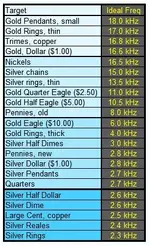The graph was put out by both Minelab and Tesoro if I remember correctly.. The reason they are ideal for different frequencies is because of their rate of decline or dissipation, or wave length or wave height, or ability to penetrate through different substances (i.e.metals). It works {something} like this: If you shine a flashlight into outer space, it eventually will dissipate to absolutely nothing, relatively speaking of course, but it has to pass through many different disturbances (interferences) just to go as far as it does, but of course I over-simplified this example just for practical understanding. Certain frequencies are of certain wavelengths or pulse rates, and some pass through substances faster and farther and even wider or more narrow, and some do not. All magnetic flux lines do the same, and so does "electricity", or current, but magnetism is not directional, it is multi-directional, save for any concentration as in a elecro-magnet when compared to a permanent magnet, although that is not very important as to this discussion. The same applies in electronics and electrical theories, although in electricity one looks at (current) as the presence of electrons moving along the least resistant path, and electronics views it as the absence of electrons (having left a hole) when passing through them, a void that needs to be replenished with another electron, but both can be viewed as either. Our metal detectors are designed with a certain frequency of operation partly because it is easier to create a circuit easier, better, and more accurate than another. But that is not a static foregone conclusion, because we can alter the frequency to fit different criteria as the rest of the circuitry requires it in order to accomplish our goals. In short, we can make a 10 kHz behave almost as well or the same as a 40 Khz radiation or 30 Khz. For example, it is not necessary to have several different operating search coils in order to create different frequencies, it can be done with just one search coil instead. However, there is one company that makes a whole lot of money selling different frequencies to people who don't have a clue as to there being no need for them all. So too, it is not always the best idea to use a metal detector with a rock solid frequency of operation or radiance because the search coil size and type is a much more important criteria as regards to how well it operates in the field. This is one of the reasons why Tesoro has such a much better overall success rate at 10 Khz over some other brands that uses 17 Khz or 3.5 Khz, it's all in the engineering, but the engineering is not a worthwhile discussion for an average metal detector enthusiast here, we just want to find stuff.






